Early Exynos 8890 Impressions And Full Specifications
by Andrei Frumusanu on February 21, 2016 6:15 PM EST- Posted in
- Smartphones
- Mobile
- SoCs
- Exynos 8890
- Exynos M1
- Samsung Galaxy S7
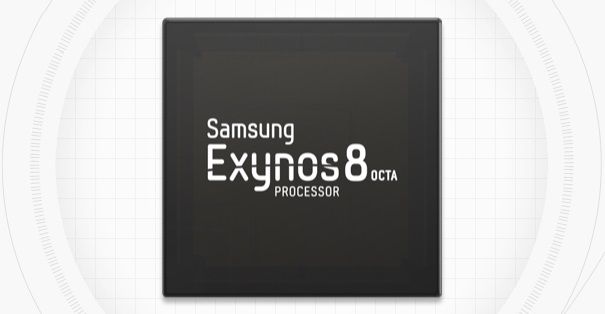
| High-End SoCs Specifications | |||
| SoC | Snapdragon 820 | Exynos 8890 | Exynos 7420 |
| CPU | 2x Kryo@1.593GHz 2x Kryo@2.150GHz |
4x A53@1.586GHz 4x Exynos M1 @ 2.60GHz (1-2 core load) 2.29GHz (3-4 core load) |
4x A53@1.50GHz 4x A57@2.1GHz |
| Memory Controller |
2x 32-bit LPDDR4 @ 1803MHz 28.8GB/s b/w |
2x 32-bit LPDDR4 @ 1794MHz 28.7GB/s b/w |
2x 32-bit LPDDR4 @ 1555MHz 24.8GB/s b/w |
| GPU | Adreno 530 @ 624MHz |
Mali T880MP12 @ 650MHz |
Mali T770MP8 @ 770MHz |
| Mfc. Process |
Samsung 14nm LPP |
Samsung 14nm LPP |
Samsung 14nm LPE |
The Exynos 8890 employs Samsung's own designed Exynos M1 cores. The micro-architecture at a high level resembles ARM's big cores, but Samsung seems to have made quite a few changes and improvements when compared to ARM's designs. While by now I do have a quite good idea of what the Exynos M1 looks like, we'll be covering the topic more in-depth in a future article once we'll be able to gain better insight from our own unit for proper benchmarking and power measurements.
On the CPU side we find an 8-core SoC composed of 4x Cortex A53 cores running at up to 1.586GHz coupled with 4x Exynos M1 cores in a big.LITTLE configuration. The most surprising revelation was the fact that the M1 cores reach an extremely high clock of up to 2.6GHz. This represents quite a significant boost over some past rumors which had put expectations 2.3-2.4GHz maximum frequency range. The catch here is that the Galaxy S7's power management doesn't allow all four cores to run at this high frequency but rather only enables the maximum clock when there's at most 2 cores loaded. If there are 3 or more cores under high load, the CPU frequency doesn't surpass 2288MHz.
On the GPU side we knew that we'd encounter a new ARM Mali T880MP12 - the currently largest Mali implementation available among existing SoCs. Back in November I theorized that Samsung would use the larger core implementation to lower the clocks of the GPU block and thus achieve better power efficiency. Indeed that's what seems to have happened as the Exynos 8890's GPU peaks at 650MHz versus the 770MHz frequency for the Exynos 7420. Hopefully this means that the new SoC will be able to maintain its peak performance for longer periods of time.
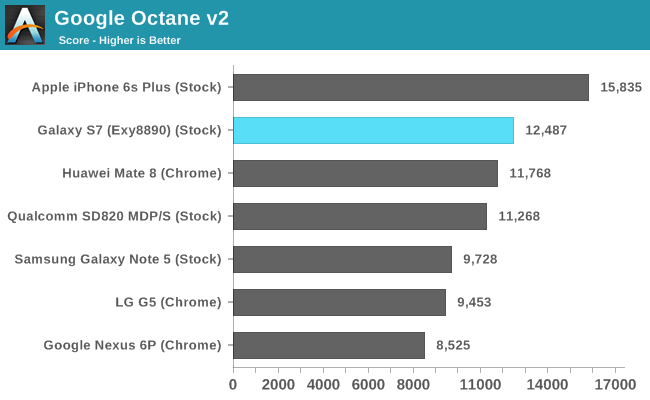
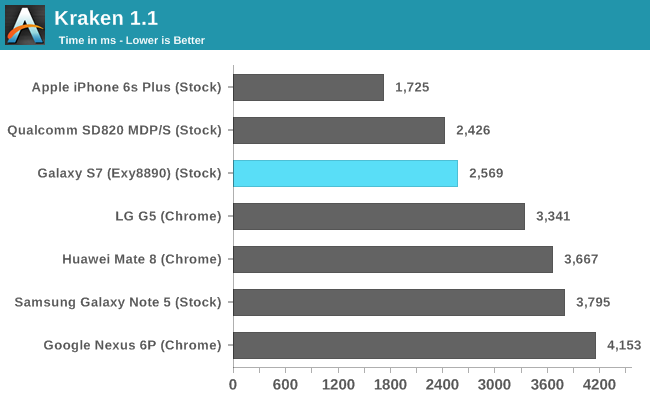
While I didn't have the time to run too many benchmarks, I did manage to run a few of our basic browser tests as well as GFXBench. We haven't had the opportunity to benchmark the Snapdragon 820 Galaxy S7 yet, therefore I included the score numbers of the MDP/S platform to represent a best-case scenario for the Snapdragon 820 until we can get apples-to-apples scores based on Samsung's browser. This still mostly due to the fact that Chrome is seemingly not yet optimized to take advantage of Kryo's new architecture, and as a result scores some rather mediocre numbers, as seen in some preliminary LG G5 numbers included in the graphs above.
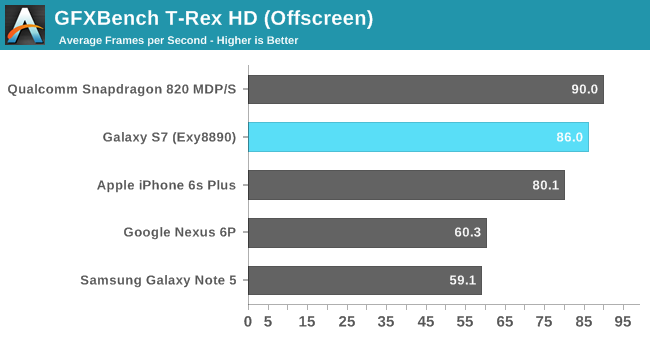
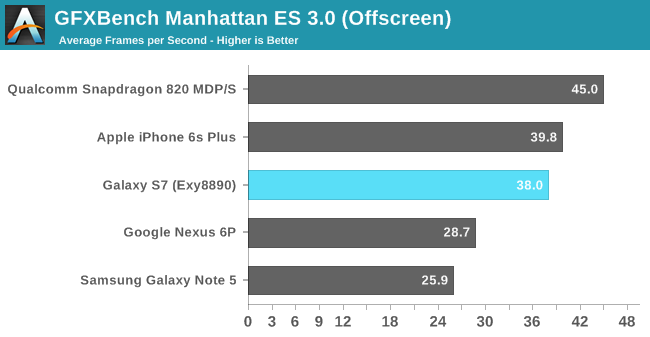
Some quick GPU benchmarks also put the Exynos 8890 slightly behind the Snapdragon 820 in the MDP/S. We will still have to see if actual Snapdragon 820 devices are able to deliver the same performance as the MDP/S platform as there might be some thermal limitations coming into play. Again, we can't comment too much on the scores before we get to know each device's long-term performance and if the attained numbers are sustainable for long periods of time.
One observation I made today which was particularly concerning, was that both with the Snapdragon 820 LG G5 as well as the Exynos 8890 Galaxy S7 got considerably warm after running some heavy workloads. The fact that the Galaxy S7 touts having a heat-pipe thermal dissipation system is a quite worrying characteristic of the phone and should in no way be seen as a positive feature as it points to high power draw figures on the part of the SoC.
The first impression is that the performance difference between the Snapdragon 820 and the Exynos 8890 doesn't seem to be very large, therefore it will be the SoC's power draws and power efficiencies which will determine if, and which one of both will represent a superior design. Hopefully in the coming weeks and months we'll be able to get a better understanding of this new generation of SoCs so that we can paint a definitive picture of the current status of the mobile SoC space.










94 Comments
View All Comments
tuxRoller - Monday, February 22, 2016 - link
Yes, but that's one app. An app that sees more development effort than any other, I believe.I think if you monitor most apps you'll see that they're mostly lightly threaded at best.
krumme - Tuesday, February 23, 2016 - link
Its the one app that matters. Its the one app people uses alle the time, and its by far the one that uses most cpu ressources.Who cares if calling or music is single threaded or not? Browsing is what matters for 99,9% of users and if any future games need more cpu grunt they will use Vulcan anyway and thereby easy access to better threading.
tuxRoller - Wednesday, February 24, 2016 - link
Way to move the goalposts.Any other ad hoc preconditions I should know about?
ciderrules - Tuesday, February 23, 2016 - link
You're completely missing the point. Loading up concurrent threads in no way means that each of those threads is doing an equal amount of work or that each of those threads are actually using the full processing power of an individual core.It's very easy to divide your program up into multiple threads to distribute the workload. It's very difficult to make sure that all those threads are doing an equal amount of work all of the time (no thread finishes early and then sits idle, for example). My original comment still stands.
lilmoe - Monday, February 22, 2016 - link
Oblivious at its best.tuxRoller - Monday, February 22, 2016 - link
You're not wrong, but simply having the ability to schedule those tasks across a big SOC makes for a more responsive system, all else being equal...but since things aren't equal you can also get a somewhat similar experience with fewer, much more powerful cores.Imho, exynos is doing something pretty interesting this year with allowing "turbo" modes for lightly threaded, but highly resident, loads. OTOH, snapdragon seems to have a pretty strong IPC advantage given there benchmarks, thus far, but we'll have to wait and see if they are sufficiently powerful enough to provide a good experience with half the cores.
Alexvrb - Monday, February 22, 2016 - link
It's an advanced big.LITTLE configuration. It can handle well-threaded and single-threaded loads equally well, multitasks well, and has good efficiency and performance. Then again the 820 has Kryo cores and they probably kick butt in a lot of scenarios too.jjj - Monday, February 22, 2016 - link
Indeed these benchmark apps are just sad.It's increasingly frustrating to keep seeing pointless synthetic benchmarks.
Bhairava - Monday, February 22, 2016 - link
I wonder why Anandtech keeps on using Octane and Kraken. Rethorical question.close - Monday, February 22, 2016 - link
Reference. Synthetic or not they are "reliable" and provide a point of reference for the tested device. This is the purpose of any benchmark regardless what area we're talking about. That is even what the word actually means. You get several known points of reference and all devices will be compared against those. Then you can find a way to map them as a subjective experience for real life applications.Would you settle for a graph where some guy just gives a subjective mark for the experience with the phone? I assume any flagship would be a 9ish. There you go, now you don't have to waste time reading these articles. :)